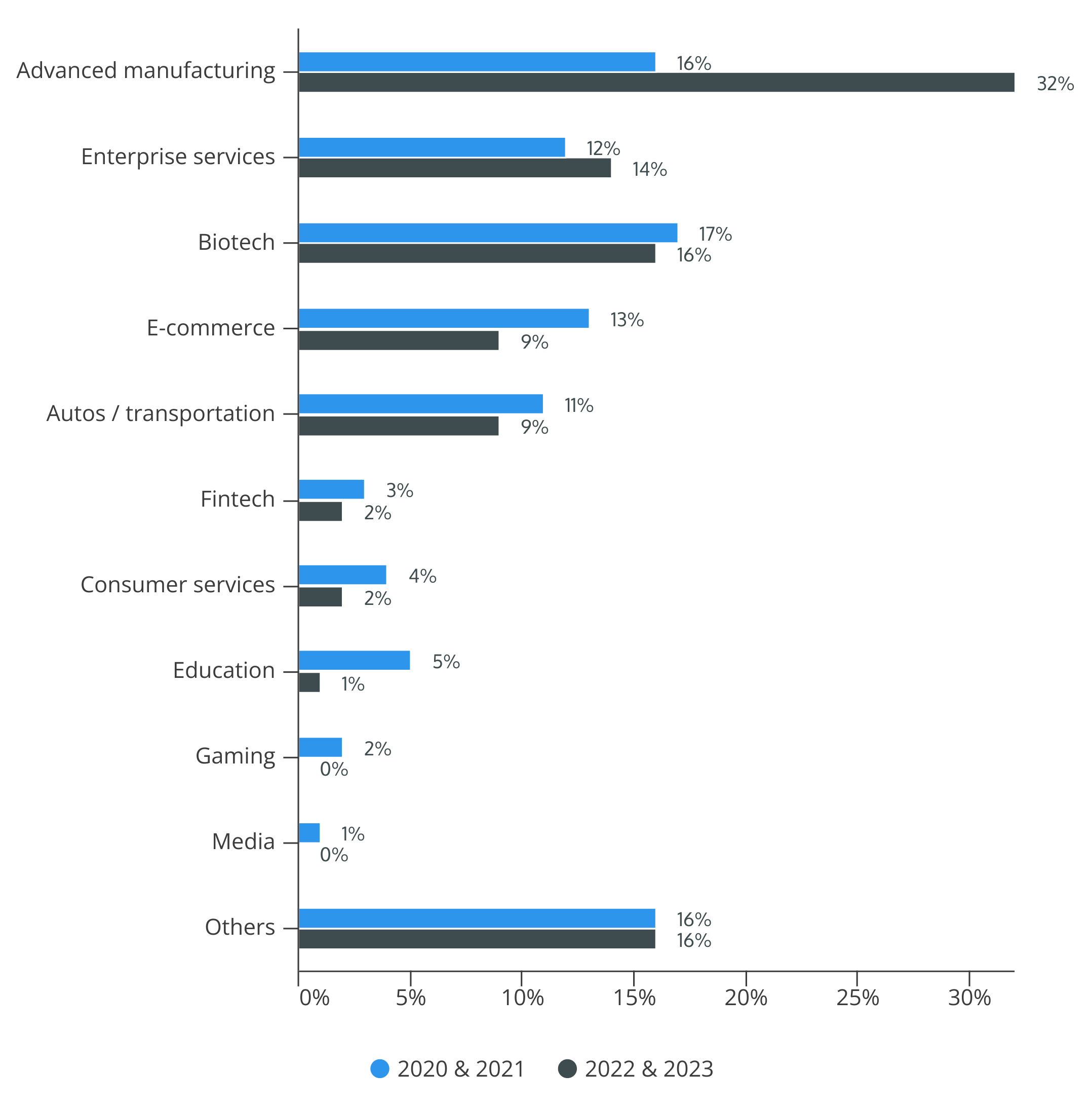- March 27, 2024 Technology
Are China’s VCs All In on Hard Tech?
There’s hardly a better bellwether of Silicon Valley venture capital (VC) than Andreesen Horowitz (a16z). For a highly influential VC firm that has long believed software is the future—its motto is “software is eating the world”—a16z raised eyebrows when it launched the “American Dynamism” portfolio in 2022. It would serve as a new vehicle for a16z to pursue investments in foundational and frontier hard tech that align with US national interest.
That technology and national interest are becoming increasingly intertwined is not a surprise, given what has transpired over the last few years between the United States and China. In fact, the Chinese government has been pursuing its own version of “Chinese Dynamism” since its pivot to hard tech around 2021, which we’ve analyzed thoroughly.
But the thing about hard tech is that it is, well, hard. A small team of coders could pound away in a café in Palo Alto or Shenzhen and push out “Clubhouse” or similar in several months. But you need a factory, a supply chain, and tons of engineers and mechanics to make a humanoid robot come to life. The cost of entry, the inherent risk, and timeline to commercialization are all higher and longer than investing in the “next Uber of X”.
And if there’s anything we know to be generally true about VCs of whatever stripe or nationality, it’s that they’re predisposed to investing in high-growth startups that can scale fast and exit quickly—rinse and repeat. That model has served VC well, but it isn’t really the type of “patient capital” that’s required to see through successes in hard tech, whether it’s chips, robotics, or rockets, among others.
So, the commingling of tech and national interest across the major economies now means that the money behind tech will have to play ball, begrudgingly or not. This is of course seen most prominently in China, where Beijing has minced no words on prioritizing high-quality growth on the back of hard tech to enhance its formidable industrial base. At the same time, Beijing has made it more difficult to invest in platform companies through a regulatory crackdown heard round the world—call it capital reallocation with Chinese characteristics.
Is that private capital actually reallocating toward hard tech then? We analyzed the investment patterns of China’s top 40 private VCs based on investment activity and rankings from reputable Chinese financial media. Examining over 5,600 VC investments between 2020-2023 that totaled $54 billion, we made two preliminary observations: 1) VC activity slowed down dramatically following the tech crackdown; 2) VC money does seem to be tilting toward hard tech in the last few years. Both suggest Chinese VCs are still finding their footing in this brave new hard tech world.
Slowdown and Shift?
The contrast couldn’t be starker before and after the 2021 tech crackdown, when both deal volumes and value plummeted 46% and 54%, respectively, during the 2022-2023 period (see Figure 1). The decline was seen across the board of the 40 VCs, with the average deal value down by 14%.
Figure 1. China’s Top 40 VCs Are Making Fewer Deals and Investing Less
Source: ITJuzi; author’s calculations.
The more cautious behavior among VCs post-2021 is perhaps to be expected—when the Chinese government manufactured a deliberate popping of a tech bubble, the money went on the sidelines. Amid the slowdown, however, there does seem to be a simultaneous shift to investing more in hard tech (see Figure 2).
Figure 2. China’s Top 40 VCs Are Putting Relatively More Money Behind Hard Tech
Note: Proportion of investment value. “Atoms” sectors include advanced manufacturing, semiconductors, biotech, automotive, logistics, construction, industrial software, agritech, blockchain, and traditional manufacturing. “Bits” sectors include enterprise software, e-commerce, fintech, consumer services, education, gaming, media & entertainment, sports, social media, advertising, travel, metaverse.
Source: ITJuzi; author’s calculations.
Advanced manufacturing seems to be a winner so far, likely because it is a very broad sector that encompasses everything from electric vehicles and CNC machines to robots and magnets. And the once VC darling sectors that were hit by the crackdown—including education, fintech, and gaming—have more or less gone dry (see Figure 3).
Figure 3. VCs Are Targeting Advanced Manufacturing Note: Proportion of investment by value across the top 40 VCs.
Note: Proportion of investment by value across the top 40 VCs.
Source: ITJuzi; author’s calculations.
Will the Shift Endure?
This shift happens to coincide with Beijing’s strategy of bolstering the industrial base and overcoming hard tech bottlenecks like chips. It allows the state to tout that unifying public and private sector efforts on technology is working. But the reality is certainly more complicated.
In the current environment, it might make sense for Chinese VCs to invest in long-term deals in hard tech that align with Beijing’s priorities, if nothing else, to mitigate some political risk. But at the same time, there aren’t that many good options at the moment, so it’s likely Chinese VCs are simply wading through unfamiliar terrain and trying to assess different opportunity sets.
Yet what is the purpose of a VC if it isn’t returning profits to its investors? Calibrating that proper balance between national interest and profit will likely shape VC strategies and determine to what extent Chinese VCs can continue to play ball on this hard tech pivot. We will further assess the durability of this shift in VC money through other indicators, such as successful exits and new funding models, as part of the broader examination of private capital’s role in achieving China’s technological and industrial objectives.
The author would like to thank Di Lu and George Wang for excellent research assistance.
Stay Updated with MacroPolo
Get on our mailing list to keep up with our analysis and new products.
Subscribe
